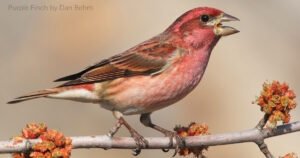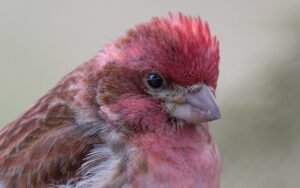The Fascinating World of Purple Finches: A Complete Guide
I. Introduction to Purple Finches
A. Physical Characteristics
Purple finches are small passerine birds known for their vibrant plumage. Adult males boast a striking crimson-red hue on their heads, backs, and throats, contrasting with brown streaks along their sides. Females and juveniles, on the other hand, exhibit more subdued colors, with streaked patterns of brown and white.
B. Habitat and Distribution
These finches inhabit various forested regions across North America, including coniferous and mixed woodlands. During the breeding season, they can be found in Canada and parts of the northern United States, while migrating to more southern areas during winter.
C. Behavior and Social Structure
Purple finches are primarily seed-eating birds, often congregating in flocks, especially during the non-breeding season. They are known for their melodious songs, which play a significant role in courtship rituals and territorial defense.
II. Diet and Feeding Habits of Purple Finches

A. Primary Diet
Purple finches predominantly feed on seeds, favoring those of various trees such as pine, spruce, and hemlock. Additionally, they may consume small insects, especially during the breeding season to supplement their diet.
B. Feeding Behavior
These finches exhibit agile foraging behavior, flitting among branches and foliage in search of food. They have strong, conical beaks adapted for cracking open seeds, allowing them to access nutritious kernels within.
C. Nesting and Breeding Season
During the breeding season, which typically spans from spring to summer, purple finches construct cup-shaped nests using twigs, grasses, and feathers. These nests are often nestled within dense foliage, providing shelter and protection for their eggs and offspring.
III. Purple Finch Song and Vocalizations
A. Song Description
The male purple finch is renowned for its melodious song, characterized by a series of rich, warbling notes. This song serves both as a means of attracting mates and establishing territory within their habitat.
B. Communication with Other Birds
In addition to their distinctive songs, purple finches communicate with conspecifics and other bird species through a variety of vocalizations, including calls and chirps. These vocal exchanges play a crucial role in social interactions and signaling potential threats.
C. Importance of Vocalizations in their Lives
Vocalizations are integral to the survival and reproductive success of purple finches. They use vocal cues to coordinate mating rituals, defend territories, and alert others to the presence of predators, highlighting the significance of sound in their daily lives.
IV. Predators and Threats to Purple Finches
A. Natural Predators
Like many small birds, purple finches face predation from a variety of natural predators, including hawks, owls, and snakes. Their cryptic plumage and agile flight help mitigate the risk of predation to some extent.
B. Human-Induced Threats
Human activities such as habitat destruction, pesticide use, and collisions with man-made structures pose significant threats to purple finch populations. Climate change also presents challenges by altering their habitats and affecting food availability.
C. Conservation Efforts
Efforts to conserve purple finch populations include habitat restoration, implementation of bird-friendly practices, and monitoring population trends. Citizen science initiatives play a crucial role in gathering data and raising awareness about the conservation needs of these birds.
V. Interaction with Humans

A. Purple Finches as Pets
While purple finches are admired for their beauty and song, they are not commonly kept as pets due to their wild nature and specific dietary and environmental requirements.
B. Birdwatching and Spotting Purple Finches
Birdwatchers and nature enthusiasts often seek out purple finches for their vibrant plumage and melodious songs. Their presence adds to the allure of birdwatching excursions, providing opportunities for observation and photography.
C. Interesting Facts and Myths about Purple Finches
Purple finches have inspired various myths and legends throughout history, with some cultures associating them with love, happiness, and good fortune. However, it’s essential to distinguish between fact and fiction when learning about these fascinating birds.
VI. Summary
In summary, purple finches are captivating birds known for their vibrant plumage, melodious songs, and agile foraging behavior. Understanding their physical characteristics, behavior, and ecological role is essential for conservation efforts and fostering appreciation for the natural world.
Frequently Asked Questions (FAQs)
Q: Are purple finches endangered? A: Purple finches are not currently listed as endangered. They are considered a species of least concern.
Q: Can purple finches mimic other bird calls? A: Purple finches do not have a mimicking behavior like some other bird species. Their vocalizations are unique to their species.
Q: How can I attract purple finches to my backyard? A: You can attract purple finches to your backyard by providing suitable food sources such as sunflower seeds and maintaining a natural habitat with trees and shrubs for nesting.
Understanding the intricate world of purple finches offers insight into the diversity and complexity of avian life. By appreciating and safeguarding these magnificent creatures, we can contribute to the preservation of our natural heritage.

